Micro Fishing New Zealand
by Tony Stevens
Have you heard the word. The word is “MICRO”: fishing that is, the western world asked what the heck is this? Micro fishing for most was a technique of spin fishing with ultra light gear however true micro fishing is Asian in origin and is epitomised in the annals of historical Japanese angling. As one would expect from such as Bonsai, the miniaturisation of trees and shrubs and many other organic species is a highly specialised product of Japanese culture. Some species of Japan’s fish are the very, very small fish called in the west Bitterling, in Japanese Tenago. Highly specialised tackle has been developed over the years to catch such tiny fish, now a cult has arisen which demands the catching of a fish of 25mm or less using rod, line and hook. In Japan dedicated bass anglers have abandoned their bait casting or spinning gear and adopted very traditional bamboo rods to follow their traditions catching small fish.
Tenago fishing is really urban fishing in a densely populated country where the chances for angling are very limited and usually in much modified waters. Rods are from 2 ft to monsters of 15ft but all use micro fine line of 2lb or less floats the size of a single peanut and hooks less than size 18, (for me in what some call declining years an 18# or 20# hook is just about invisible) to go out and catch fish and enjoy this back to nature experience.
I have had the luck to know a Japanese friend Yoshi Sakamura that was not just a trout fly fisherman but a very knowledgeable practitioner of traditional Japanese angling. The art of fixed line fly fishing known as Tenkara I was able to embrace with no difficulty but the concept of trying to catch a fish of less than 25mm proved a little bit of a challenge to credulity. However the challenge proved too great to dismiss out of hand. “Anyone can catch tiddlers” proved Oh! so wrong. It is easy to catch a 10cm fish be it rudd, perch or native species but to catch a truly micro fish is incredibly hard. For a year I have intermittently tried a variety of my favourite fishing venues with micro gear to get down to somewhere near that magic 25mm fish. I have had a lot of fun, caught a lot of fish including species I have only read about but to date have come nowhere near that magical 25mm.
The gear. Micro fishing is once again a collectors treasure house if that is the road that interests you, there is a whole new field of antique and repro Tenago gear to whet your collectors appetite but for all practical purposes $50 to $100 bucks will buy all you need for many years of fun. The rod; ideally this is a telescopic whip from 6 to 15 ft. very flexible with a very fine tip to handle very fine lines. I found that the advise to buy a long rod very good. It is easy to subtract lengths from the butt of a longer rod than to find that your 6 or 9ft rod is too short for where you fish on the day. Lines are easy, a 25m spool of Maxima 2lb Ultra Green has it all. Hooks are available from any good trout fishing source, I use Kamasan B830 in sizes 20# 18# and 16#.. Hook link I found in a haberdashery shop sold as sewing monofilament thread. Clear tested at 0.75lb and dark at 0.5lb. Shotting proved quite easy too as thin lead sheet off cuts from roofing lead from the local plumber made excellent style weights. Floats are the big problem, unless you make your own from toothpicks and balsa wood improvisation is the name of the game. Match sticks with two bands of silicon rubber to hold the line is one option as are small bird quills. I guess that very small pole floats taking no more than 2xNo6shot would be ok. A piece of stiff closed cell foam makes a good line winder for holding made up tackles. All this will fit into a small bag and will take up less room than your lunch.
Bait can be anything that is used for larger fish. Bread in all it’s forms, worms, maggots, larvae and best of all paste. A Japanese paste recipe is fantastic and will catch just about any fish that swims in fresh water. Mix 1 dessert spoon of Gluten flour with 5 drops of fish oil then add boiling water to make a soft paste. This will be highly elastic and stay on the hook for multiple catches. It keeps in the freezer well and will last for many trips.
What can you expect to catch? Here in New Zealand by far the largest group will be native species. Bullies of various kinds can be found in both running water and in still, Smelts are usually a river fish from the lower reaches of the systems then come the Inanga and other similar species akin to whitebait. These latter all spawn in the lower reaches of rivers then the Alvin go to sea to return as juveniles, move up into the suitable habitats to mature into adults. Then there are the estuarine species which come up into fresh water mostly during summer such as mullet and flounder, of these there is a wee fellah the black flounder which seems to be solely freshwater.
This little fish the NZ Torrent fish is only found in New Zealand and is far more common than thought and as it’s name suggests is found is fast stony sections of streams and rivers and a real feather in the cap of the “Micro Angler”. Other fishes are the traditional realm of both game and coarse anglers and are the juveniles of the traditional quarry.
Techniques used are the common ones to coarse anglers, float fishing being the most common with the micro paternoster an occasional handy method to cope with fast water if after some of the bullies or torrent fish. Smelt and mullet will take an artificial fly but unless you can tie your own down to size 18 or 20 finding the flies is difficult. The preferred method is to use a short link paternoster, no more than 6ins, cast out and jig the fly back to you in very short hops. This technique can give some surprises and some quite large fish latch on to the fly; trout being the most common closely followed be perch and large mullet. Always try to suit the technique to the water. If it is a small brook with shallow streamy water the paternoster is a good way to fish. A deeper stream, pool, lake, pond or river suits the float best and the margins are almost invariably the areas to target. Look for structure, small fish like to hide and structure is where they will usually be. Structure can be weeds, margin plants such as rushes and reed stems, fallen debris such as trees are always good. And in the streams rocky water that forms pockets of slack will invariably produce. Even the margins of really aggressive white water will hold fish especially small fish. For bait the paste talked of is my mainstay go to first, second is worm segments followed by freshwater shrimp and nymphs from under rocks etc. All baits need to be small, a size 20 hook means a bait about the size of half a grain of cooked rice and leave the hook point clear otherwise hook-ups are hard to achieve.
The following is what happened in a two hour session on the lower Heathcote River micro fishing. It is ten am on a fine summers day, little wind and I am in a rush bed with just a small gap leading to open water. First a walnut size ball of damp bread crumb is tossed out a couple of yards from the margin and another on the edge of the rushes. I am using 9ft of the 15ft whip and float dotted down so just the merest piece of tip shows. Paste is bait on a size 18 hook. The bait is floated down out in the current and near the end where the bait will have risen the float buries! My first smelt of the day swings to hand.
I fish on, I catch some and miss still more a steady trickle of ground bait keeps them coming. Then I find that the mullet have arrived, a half pound mullet is a real struggle on this micro gear so to give me a better chance I add the rest of the sections of the rod. I go on catching smelt until the float zips away and a larger mullet is on. The battle is fierce but the flex in the rod wins and a 12in mullet is carefully eased ashore to be unhooked and returned to its interrupted watery existence. During this session I also caught a trout parr and a small black flounder from the rush edge under my feet. Then disaster struck; the float slowly descended and stayed static in view under the surface. With the full knowledge I gingerly lifted the rod tip and felt the tell tail thumping of an eel backing off. I did try but to no avail, I did see the culprit, about 2 1/2ft in length. It had taken the tiny bait in water only a foot deep and was far too big for the micro gear and so we parted company me minus the tiny hook. That was a good point at which to stop and go home for lunch. I had had a lovely morning with about forty assorted fish.
The rod was collapsed, the line put back on a pole winder, a traditional Japanese bamboo style one; everything packed away in a satchel and off I went a very happy man. Give it a try, don’t get serious, just have some fun and just indecently your kids will love it and have a wonderful introduction to the world of angling.
NOTE:
The Rod is from DINO DIRECT www.dinodirect.com and is a “Heng Sheng” 450 cost landed in your hand about $50.00. These are great as the collapsed length is only
15 1/2in. and very light. Besides this rod are many more from 6ft to a massive 33ft
Floats are hand made from cane stems and balsa wood bodies. I buy ½ and ¾ in. square section balsa, the wood is cut to length drilled and a stem super glued in; the body roughly cut to shape with a craft knife. The lower stem is then inserted into an electric drill which is used as a lathe, sand paper is used to form the desired form and size. I paint mine with acrylic colour then varnish with a good rod varnish.
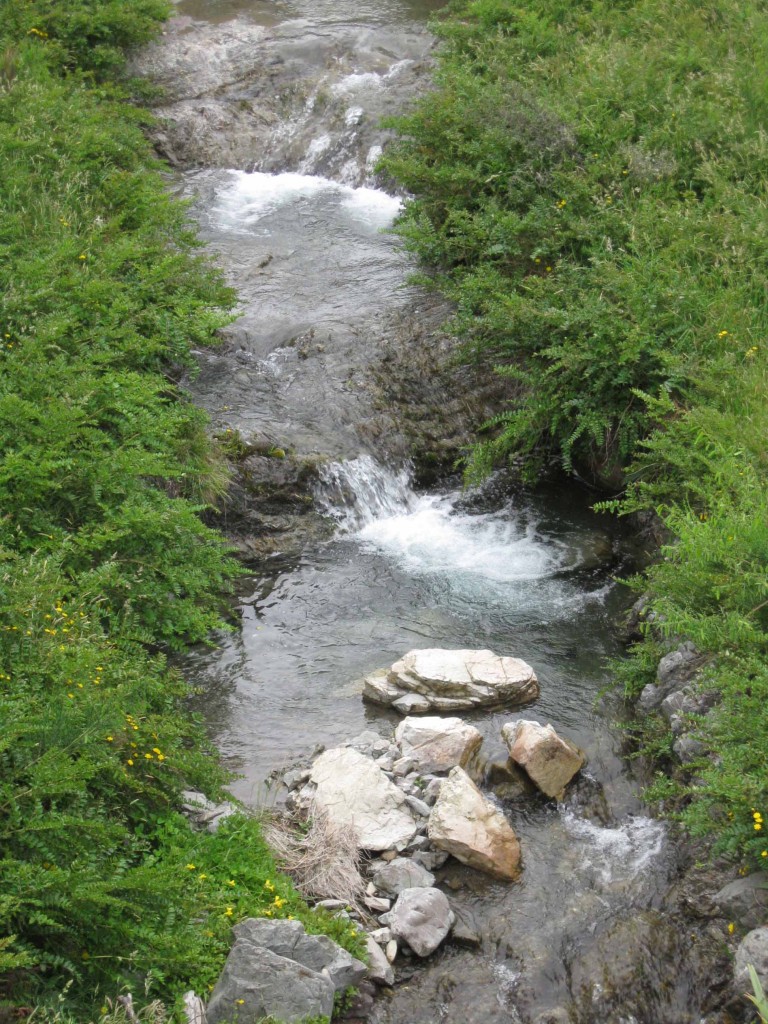
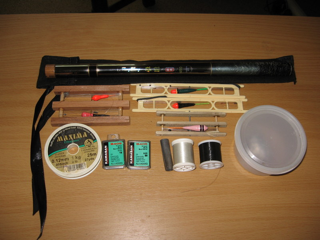
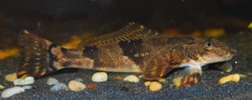
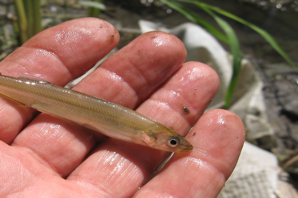
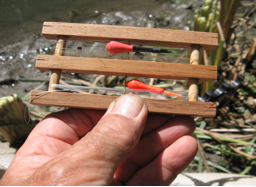
Comments
Post a Comment